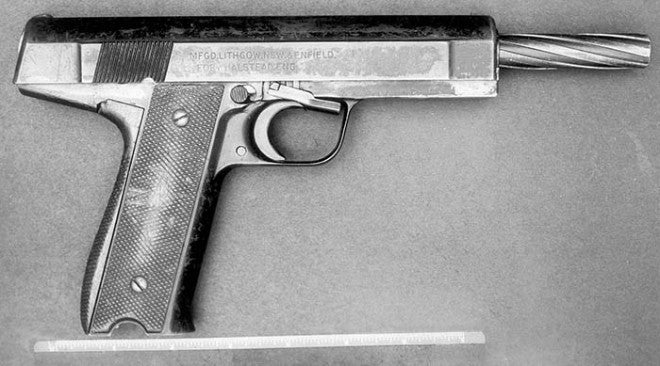Small Arms Review has an excellent article on the little-known Robinson Machine Pistol, an Australian hand-held automatic weapon in 9mm. The Robinson uses a mechanism somewhat like the QX-04 handgun covered on this site in a previous article, but closer in some ways to a standard advanced primer ignition (API) blowback submachine gun. The barrel, like the QX-04 was spiral-grooved, which provided resistance against unlocking due to the engraving of the bullet against the rifling, but the weapon operated in the open bolt mode, with ignition occurring during the forward movement of the slide:
When the trigger is pressed, the slide is accelerated forward by the driving spring, the rear end of which bears rearward against the barrel and holds it against its rear stop. As the slide moves forward, it forces the barrel to rotate at a fairly constant angular speed by the grooves in the slide nut engaging the external grooves on the barrel. By the time the slide reaches forward or firing position, the rotational energy of the barrel is about one half that of the fired bullet. When the fixed firing pin of the slide strikes the primer and ignites the charge, a very slight delay occurs while combustion fully develops. At the speed the slide is moving, it wants to move about .030 inches before the recoil is sufficient to arrest and then reverse the motion of the slide. Because of this delay, the slide is arrested in 9mm weapons not by recoil, but by the slide striking the fixed barrel and frame via the fully chambered cartridge case. The greater part of the forward energy of the slide is dispersed into the frame or pistol grip. In order to make the forward energy or movement of the slide fully available to pre-absorb almost one half of the recoil, the barrel of the Model 11 is allowed to slide forward with the slide.
As the bullet leaves the muzzle it has about twice the rotational energy as that of the rotating barrel, so the barrel rotation is arrested and reversed by the rotating bullet. But as the slide moves rearward, the barrel’s rotation is decelerated so that the decelerating torque is in the same sense as the accelerating torque when the slide is going forward. Thus the heavy torque impulse to spin the bullet is replaced by a continuous very small torque which is applied throughout the entire cycle of fire, and which is too small to affect aim during automatic firing.
Each cycle of fire in the Model 11 is followed by a small cushioned blow of the slide against the rear buffer of the pistol grip, which represents a reserve of energy to provide for elevated firing or firing under foul conditions. The blows against the buffer can be felt, but they are very small compared with usual 9mm recoil. The Model 11 was not a true constant reaction gun but it employed a combination of the constant reaction principle with rotating the barrel in the direction of projectile spin, and recoil was reduced greatly by this unique combination. Robinson found that the rapid firing of the gun produced a succession of reactive torque impacts upon the gun, thus affecting accuracy. There is a tendency for such a firearm to react with non-axial twisting pulses. And if these impacts could be cushioned so that the impact is applied to the gun over a long time, then the effects on accuracy due to imparting bullet spin in a very light weapon can be virtually eliminated. The selector mechanism used with the Model 11 is a simple three-position system. The selector is ambidextrous and can be used with either trigger finger. The full-auto position is when the selector lever is fully up and parallel with the slide. Moving the selector lever downwards about 20 degrees clicks it into semi-auto position; and in the safe position the selector lever is fully down and blocking access to the trigger while internally locking the sear.
Ejection of empty cases is via an ejection port in the top of the slide. With the exception of a magazine change, all operations necessary to use the gun require only one hand, thus meeting a major specification laid down back in Australia. Magazine capacity was 14 rounds for the initial holster friendly magazine, and 30 for the subsequent magazines.
With the slide in the “normal” position for a semi-automatic handgun, the Robinson is unlocked; like an open-bolt submachine gun the slide moves forward from that position to strip a round from the magazine, rotate the barrel, and fire the cartridge, fully automatically. In theory, this gave the weapon very controllable recoil, allowing for a handy package while providing comparable firepower to a Sten or Owen submachine gun.

One unique feature of the gun was its automatically-ejecting magazine:
The automatic ejection of the magazine is accomplished by an ejection system that is triggered when the rising magazine follower strikes the magazine retainer when it rises to the top of the magazine. The release of the magazine retainer permits the magazine ejector to thrust the magazine downward and out of the butt. At the same time, a heel on the ejector rises and holds the slide slightly to the rear of the sear position. When a loaded magazine is thrust in place, the magazine ejector is rocked upward by the rear wall of the magazine and its heel is withdrawn allowing the slide to move forward .025 inches to rear (cocked) position, and the gun is ready to fire.
The Robinson Model 11 was certainly ahead of its time in many ways, and it incorporated a number of clever concepts that, while the gun itself was not successful, clearly show that a lot of thinking went into the final product.
 Your Privacy Choices
Your Privacy Choices
